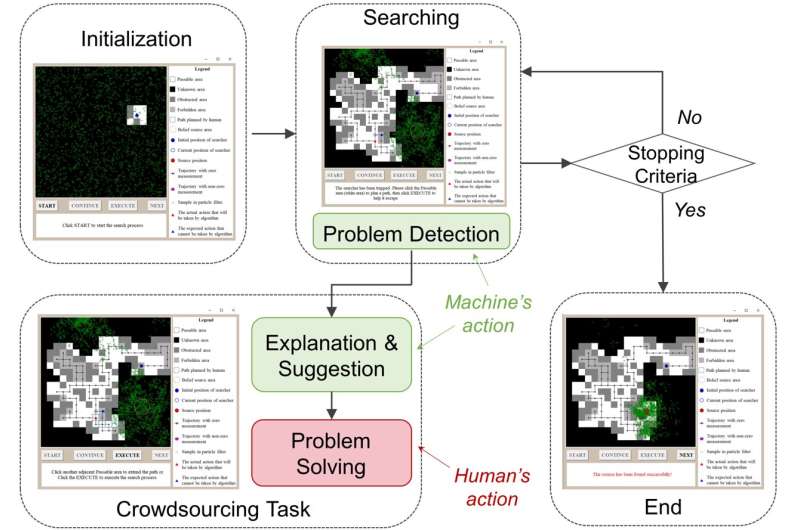This article has been reviewed according to Science X's editorial process and policies. Editors have highlighted the following attributes while ensuring the content's credibility:
fact-checked
proofread
'It is time to bring humans back': Human-AI collaboration improves source search outcomes

When artificial intelligence robots that have been designed to use algorithms to complete source search tasks, such as search and rescue operations during a fire, encounter a disturbance, they are often unable to complete their task. Proposed solutions have ranged from trying to improve algorithms to introducing additional robots, but these AI-driven robots still encounter fatal problems.
Researchers have proposed a solution: a human-AI collaboration that takes advantages of the unique skills of the human brain to overcome challenges.
The paper was published in the Journal of Social Computing.
"It is time to bring humans back," said Yong Zhao, a researcher from Changsha, China.
"AI-driven robots are often used in situations when physical search would be too dangerous or physically impossible for people, such as locating the origin of a fire or identifying the source of toxic gas. However, AI robots can encounter critical problems that cannot be resolved autonomously, such as getting stuck or misidentifying the source. These are problems that are easily tackled by humans using their expertise, experience, and even instincts. A crowd-powered system offers a novel solution."
To prove the feasibility of their human-AI collaboration strategy, researchers first identified the different types of hazards the robots could encounter. These hazards were then sorted into whether or not a human observer could help AI solve the problem. If the problem cannot be solved with human assistance, for example, if the search area is too large, then the search is stopped. However, if the problem could be solved with human assistance, the AI develops an explanation of the problem, and it is sent for crowdsourcing.
"Involving humans in the automated problem-solving process enhances the efficacy and efficiency of the algorithm. In scenarios where the robot faces challenges due to dynamic, deteriorated, or unfamiliar environments, temporary human intervention can be employed without prior knowledge of the surroundings to address these issues. Once resolved, AI seamlessly resumes control over the robot to continue its search," said Sihang Qiu.
After identifying the different types of hazards and whether or not humans could assist in source search scenarios, researchers developed a user study. The user study tested two different control modes of the AI robot—Full Control and Aided Control. In Full Control, the human collaborator takes over the search process. In Aided Control, the problem-solving decision tree decides if the human-AI collaboration would be beneficial.
During Aided Control, when they received information from the algorithm about the problem and did not give over complete control, participants felt like they had less cognitive workload and could address the problem. However, non-experts had a harder time understanding the AI-driven robot's explanations of the problem, leading the researchers to propose personalized interactions based on the experience of the human in the collaboration, including plain language explanations.
Looking ahead, researchers will try to find ways to include additional personalization, based on the human participants' background, education level, and personality. "This study paves the way for our future exploration into harnessing crowd-powered systems to facilitate effective collaboration between humans and AI. Our aim is to substantiate the manifold advantages of such collaboration in diverse application scenarios, including but not limited to natural language processing and image analysis," said Qiu.
More information: Yong Zhao et al, Leveraging Human-AI Collaboration in Crowd-Powered Source Search: A Preliminary Study, Journal of Social Computing (2023). DOI: 10.23919/JSC.2023.0002



















